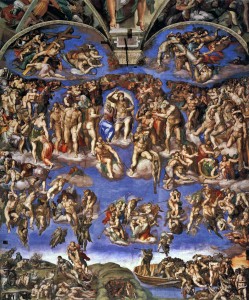| The Last Judgment | |
|---|---|
 |
|
| Artist | Michelangelo |
| Year | 1537-1541 |
| Medium | Fresco |
| Location | Sistine Chapel, Vatican City |
| Dimensions | 539.3 in × 472.4 in |
| 1370 cm × 1200 cm | |
Prominently placed in the Sistine Chapel, The Last Judgment is a breathtaking fresco painted by Michelangelo. Michelangelo di Lodovico Buonarroti Simoni was an Italian painter, poet and sculptor. He was one of the most famous artists of that time. It took four years to complete the painting and it was done between 1536 & 1541.
This mighty composition spans the entire wall behind the altar of Sistine Chapel. The Last Judgment is one of the artist’s last works of art, which offers a concrete example of controversies of the day. The painting became famous for both its display of artistic genius as well as outrageous response from people due to its scandalous content.
Pope Paul III believed in the artistic abilities of Michelangelo and commissioned him to paint The Last Judgment. Originally, the painting was commissioned by Pope Clement VII, who had chosen the subject of resurrection for the painting. But, after the death of Pope Clement, his successor Pope Paul changed the subject to Last Judgment, as he felt it more appropriate for the 1530s Rome.
About the Painting
The painting, Last Judgment depicts the ending of the world where the judgment is going to be held in front of the Christ. This artwork portrays the excellence of the figures and the extraordinary roundness of the contour. The painting marks the radical departure of traditional depictions of the Last Judgment.
In the medieval times figures were dressed according to their positions. However, Michelangelo introduced a new groundbreaking concept where he presented all the figures equalized in their nudity, irrespective of their ranks and hierarchy. The artist painted male nudes whirling and soaring in a deep blue sky. The painting exhibits great artistic skills of Michelangelo- where he imagined different poses for picture and then successfully executed them. Michelangelo has mastery over body and he astounds the viewers with his perfection and excellence in creating figures that look original.
The central figure of this masterpiece is Christ, who is painted as broad and powerful. The entire painting revolves around Christ, where the saved are rejoicing and enjoying in joy and the damned ones are taken off to the underworld in darkness. With his left hand, Christ is pulling up the saved people, whereas with his right hand, he consigns the damned to Hell. The entire fresco is dominated by the tones of flesh and the sky. On one side, the Virgin Mary is sitting quietly by her son’s side.
The painting depicts important mythological figures: Charon, Minos and St. Bartholomew. In the painting, Charon, who is the gatekeeper of river Styx, takes the condemned souls to Hell’s mouth. Michelangelo gave ember color to the eyes of Charon. On the right hand side of the bottom of the painting, the artist painted Mimos, the king of Hell. A serpent is bound tightly round the body of Mimos. This masterpiece depicts the horrifying contrasts by placing glorious freedom of figures on one end and torturous souls on the other, giving the painting a terrifying appeal.
The Last Judgment dealt with an especially evocative subject, and the artist successfully engaged viewers by creating highly imaginative scenes that reflect both fear as well as hope.
Controversy over Last Judgment
The Last Judgment is no less than a subject of criticism and caused violent reactions among the contemporaries. The controversy stemmed from the nudity of figures, especially those of saints. Messer Biagio da Cesena criticized this work of Michelangelo. He considered it disgraceful to paint the nakedness and shamelessness of figures in Chapel. He was also attacked for displaying ‘impiety of religion’. Michelangelo’s masterpiece created a controversy between art and religion, where he was critiqued for using Bible as his inspiration for this fresco and mythological figures as poses in his painting.
Later on after his death, few changes were made in the painting, in which the nakedness of the figures was covered. The mythological figures were not touched and left as such. These changes were made by his student, Danielle Da Volterra. The painting was restored between 1980 and 1991.
Although the painting was heavily criticized by Roman Catholic Church, it gained much popularity due to its religious reformation that was brought by Michelangelo. The glorious painting demonstrates one of his greatest art works.